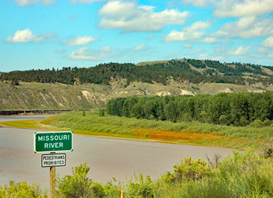BLM Opening Kipp for Recreation
Organization:
Media Contact:

the north end of Fred Robinson Bridge
at James Kipp Recreation Area, Montana.
(BLM photo Jonathan Moor)
(FORT BENTON, Mont.) – In North Central Montana, March came in like a lion and went out like a lamb… white as snow. However, the second week of April uncovered the missing warm weather, making conditions right for the Bureau of Land Management to open the James Kipp Recreation Area.
The James Kipp Campground opens April 11.
Last week the Kipp Boat Ramp was still full of ice. However, the weather warm up was quicker than expected.
Upper Missouri River Breaks National Monument Manager Josh Chase will open the Kipp Boat Ramp as soon as the ramp is cleared. “Debris removal operations have begun to clear the Kipp Boat Ramp of debris deposited by the ice break-up,” Chase explained. “The ramp is expected to be ready by mid-week next week or earlier.”
The popular recreational area is available for the American public to enjoy throughout the prime outdoor recreation months.
The BLM is making America great through shared conservation. As stewards, the BLM manages public lands for the benefit of current and future generations, supporting conservation as we pursue our multiple-use mission.
James Kipp Recreation Area is located where U.S. Highway 191 crosses the Missouri River on the Fred Robinson Bridge, approximately 20 miles north of Bohemian Corner in north central Montana.
Spring time boaters should check ice conditions before venturing to the river. For more information, call the BLM Offices in Havre (406) 262-2820, Lewistown (406) 538-1900 or Fort Benton (406) 622-4000.
The BLM manages more than 245 million acres of public land located primarily in 12 western states, including Alaska, on behalf of the American people. The BLM also administers 700 million acres of sub-surface mineral estate throughout the nation. Our mission is to sustain the health, diversity, and productivity of America’s public lands for the use and enjoyment of present and future generations.
